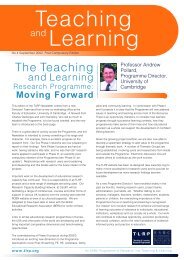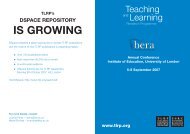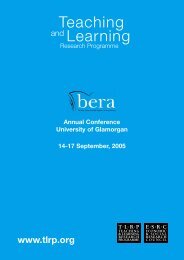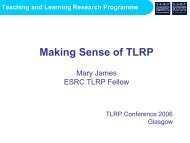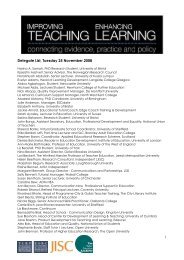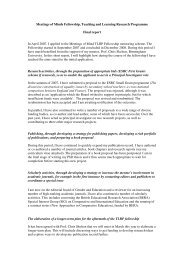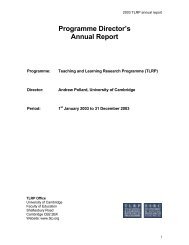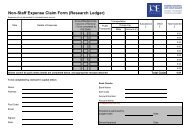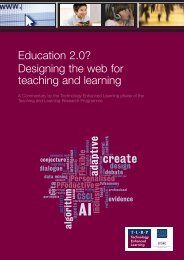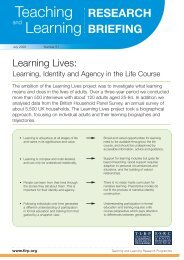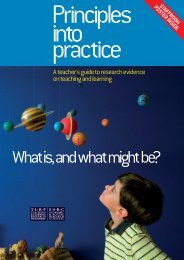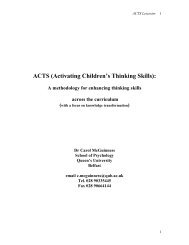The researchThis TLRP project addresses children'saw<strong>are</strong>ness of <strong>morphemes</strong> and the benefitsthat aw<strong>are</strong>ness of <strong>morphemes</strong> br<strong>in</strong>gs tochildren’s language and <strong>literacy</strong>development. Morphemes <strong>are</strong> units ofmean<strong>in</strong>g that have a fixed spell<strong>in</strong>g <strong>in</strong>English. There <strong>are</strong> two types of<strong>morphemes</strong>: stems (or base forms), whichcan often appear on their own, and affixes,which cannot appear on their own. Affixes<strong>are</strong> added to stems and <strong>in</strong>fluence theword’s mean<strong>in</strong>g. The word ‘read’, forexample, has a s<strong>in</strong>gle morpheme, which isits base form. We add ‘s’ to ‘read’ whenwe <strong>are</strong> referr<strong>in</strong>g to the third person s<strong>in</strong>gularof this verb (he reads, she reads). We canalso add the suffix ‘er’ to ‘read’; ‘reader’ isa person who reads. We could add thesuffix ‘able’ and have the adjective‘readable’. To this word we could add theprefix ‘un’ and have the word ‘unreadable’.Children who have a good level ofaw<strong>are</strong>ness of <strong>morphemes</strong> – both stemsand affixes – also have a sound wordattack strategy that can help them withspell<strong>in</strong>g and <strong>in</strong> develop<strong>in</strong>g their vocabulary.Morphemes give an <strong>in</strong>dication of themean<strong>in</strong>g of words and also have a fixedspell<strong>in</strong>g. Because <strong>morphemes</strong> <strong>are</strong>represented <strong>in</strong> spell<strong>in</strong>g, many words thatwould seem to have an unpredictable orirregular spell<strong>in</strong>g can actually be consideredregular. This is the case of the word‘magician’, which is written by add<strong>in</strong>g ‘ian’to ‘magic’, to form a person word, and ofmany other words. For example, the words‘confession’ and ‘magician’ sound exactlythe same <strong>in</strong> the end but <strong>are</strong> spelleddifferently. We argued that ‘magician’ isregular: is ‘confession’ irregular then? Theanswer is no: ‘confession’ is written byadd<strong>in</strong>g ‘ion’, a suffix used to form abstractnouns, to the word ‘confess’. It is just asregular as ‘magician’.A survey of 7,377 <strong>primary</strong> <strong>school</strong> children <strong>in</strong>Years 5 and 6 <strong>in</strong> the County of Avon showedthat children do not simply catch the spell<strong>in</strong>gof words like ‘magician’ and ‘electrician’.They cannot tell when word end<strong>in</strong>gs thatsound the same – like ‘emotion’ and‘electrician’ – should be spelled with ‘ion’ or‘ian’. Although they used ‘ion’ more often <strong>in</strong>the right than <strong>in</strong> the wrong place (e.g. <strong>in</strong>‘emotion’ than <strong>in</strong> ‘electrician’), they also used‘ion’ more often than ‘ian’ when they shouldhave used the suffix ‘ian’ (e.g. ‘electrician’was spelled as ‘electrition’ by 1,812 childre nw h e reas it was spelled correctly by only 785c h i l d ren).Work<strong>in</strong>g with several <strong>school</strong>s <strong>in</strong> Oxford, weanalysed how children’s aw<strong>are</strong>ness of<strong>morphemes</strong> relates to spell<strong>in</strong>g and whetherit is possible to improve children’s spell<strong>in</strong>gby boost<strong>in</strong>g their aw<strong>are</strong>ness of<strong>morphemes</strong>. Later, with the participation of<strong>school</strong>s <strong>in</strong> the Hill<strong>in</strong>gdon Cluster ofExcellence, we also analysed whether it ispossible to improve children’s vocabularyand their word attack strategies for<strong>in</strong>terpret<strong>in</strong>g novel words by boost<strong>in</strong>g theiraw<strong>are</strong>ness of <strong>morphemes</strong>.The teach<strong>in</strong>g of spell<strong>in</strong>gThe project started by document<strong>in</strong>gwhether and how teachers <strong>in</strong> Key Stage 2use <strong>morphemes</strong> <strong>in</strong> teach<strong>in</strong>g spell<strong>in</strong>g.Analyses of 50 transcribed <strong>in</strong>terviews withteachers about the teach<strong>in</strong>g of spell<strong>in</strong>gshowed that teachers have explicitknowledge of some aspects of <strong>morphemes</strong>but not all. The word ‘morpheme’ wasnever spontaneously used, but mostteachers mentioned prefixes and suffixes(82 per cent), and the use of ‘ed’ to changeverbs to past tense (62 per cent). The ‘ed’end<strong>in</strong>g was nearly always associated withits mean<strong>in</strong>g function. However, only 36 percent of teachers (n=18) referred to themean<strong>in</strong>g of <strong>morphemes</strong> <strong>in</strong> other contexts.When they did, it was more likely to be <strong>in</strong>the context of a prefix like ‘un’ or ‘pre’ thanof derivational suffixes such as ‘ness’ or‘ion’. The majority talked about <strong>morphemes</strong><strong>in</strong> terms of visual features (‘letter str<strong>in</strong>gs’ or‘patterns’). However, the idea of fixed letterstr<strong>in</strong>gs cannot help differentiate betweenthe end<strong>in</strong>gs of words like ‘confession’ and‘magician’ because these two words bothconta<strong>in</strong> fixed letter str<strong>in</strong>gs. Only a referenceto mean<strong>in</strong>g would help <strong>in</strong> this case.Each teacher was also observed (and <strong>in</strong> 46out of 50 cases videotaped) for oneLiteracy Hour. These observationsconfirmed that explicit mention of themean<strong>in</strong>g function of <strong>morphemes</strong> was r<strong>are</strong>.Only three observed events (out of 88) hadsome relationship to morphology and therewas reference to mean<strong>in</strong>g <strong>in</strong> only two ofthese, both <strong>in</strong> very specific contexts suchas add<strong>in</strong>g ‘s’ to make a plural. Teachers’explicit knowledge and use of <strong>morphemes</strong><strong>in</strong> teach<strong>in</strong>g reflects the documentation ofthe National Literary Strategy (NLS), andsome aspects of <strong>morphemes</strong> that <strong>are</strong> mosttransp<strong>are</strong>nt.The use of <strong>morphemes</strong> <strong>in</strong> teach<strong>in</strong>g spell<strong>in</strong>ghas not been <strong>in</strong>corporated much <strong>in</strong>to theNLS. Although a few programmes forteach<strong>in</strong>g spell<strong>in</strong>g, particularly somedeveloped <strong>in</strong> the US, have suggested that itis important to teach children about<strong>morphemes</strong>, these programmes haveneither produced methods that appealed toteachers and children nor the evidence toshow that they <strong>are</strong> effective. It seems‘logical’ that children should be taughtabout <strong>morphemes</strong>, but our project neededto produce the evidence required by theNLS, by show<strong>in</strong>g that <strong>morphemes</strong> could beused effectively and acceptably <strong>in</strong> teach<strong>in</strong>gwithout alienat<strong>in</strong>g children or their teachers.Basel<strong>in</strong>e surveysIn order to see whether there is a real needto teach children about <strong>morphemes</strong>,different surveys were conducted with KeyStage 2 children. Earlier on we referred to amajor survey carried out with more than7,000 children <strong>in</strong> the County of Avon anddocumented their difficulty with wordsend<strong>in</strong>g <strong>in</strong> ‘ian’ and ‘ion’.We carried out other surveys <strong>in</strong> Oxford andLondon, as part of this and of previousprojects supported by the ESRC and MRC.These <strong>in</strong>cluded spell<strong>in</strong>gs by more than1,000 children of words with a variety of<strong>morphemes</strong>. A wide age range wascovered, from 6 to 11 years. The surveys allshow that children do not reliably spellwords that <strong>are</strong> not phonetically regular,even though they <strong>are</strong> morphemicallyregular. Even when the children know thatcerta<strong>in</strong> letter str<strong>in</strong>gs <strong>are</strong> possible end<strong>in</strong>gsfor words, such as ‘ed’ and ‘ion’, they oftenuse these end<strong>in</strong>gs <strong>in</strong>discrim<strong>in</strong>ately, <strong>in</strong> theright as well as <strong>in</strong> the wrong places. Explicitteach<strong>in</strong>g would seem to be the answer tothis problem.Intervention studies with childrenIn order to design an effective <strong>in</strong>terventionprogramme, several small studies werecarried out to test the characteristics oftasks that work.Figure 1: Example of an analogy game thathelped with the dist<strong>in</strong>ction between ‘ion’and ‘ian’In one study three groups of childrenreceived the same amount of practice <strong>in</strong>try<strong>in</strong>g to learn the spell<strong>in</strong>g of words end<strong>in</strong>g<strong>in</strong> ‘ion’ and ‘ian’. One group was never toldthat these end<strong>in</strong>gs <strong>are</strong> used to formdifferent types of words. They wereexpected to learn the spell<strong>in</strong>g bythemselves, through practice. The secondgroup had the opportunity to try to discoverhow the spell<strong>in</strong>g of the word-end<strong>in</strong>gsworked. They were told the rule half-waythrough the exercises. A third group wastold the rule about ‘ian’ and ‘ion’ suffixes atthe start of the tasks and then had to try touse this <strong>in</strong>formation to work out correctspell<strong>in</strong>gs. The measures used at pre- andpost-test <strong>in</strong>volved spell<strong>in</strong>g words as well aspseudo-words with ‘ion’ and ‘ian’ end<strong>in</strong>gs.Although the children <strong>in</strong> all three groupssolved the same spell<strong>in</strong>g tasks <strong>in</strong> the sameorder, only the two groups who were taughtthe rule explicitly showed consistently betterperformance than a comparison group whohad worked on a different <strong>literacy</strong> task.After these small studies, we designed aprogramme to teach children how toidentify the <strong>morphemes</strong> that composemulti-morphemic words <strong>in</strong> order to analysetheir mean<strong>in</strong>g and spell them correctly. Ourmaterials, which were delivered us<strong>in</strong>g ITwww.tlrp.orgTeac hi ng and Lear ni ng Resea rch Pro g r a m m e
Major implicationsOur re s e a rch demonstrates that knowledge of <strong>morphemes</strong> can help children learn<strong>in</strong>g tospell English words, and that it is quite easy to promote this knowledge <strong>in</strong> pupils <strong>in</strong> anattractive and <strong>in</strong>terest<strong>in</strong>g way. We have also shown that for the most part teachersthemselves <strong>are</strong> not explicitly aw<strong>are</strong> of the importance of <strong>morphemes</strong>, but with the help ofspecial courses can easily <strong>in</strong>corporate <strong>in</strong>struction about <strong>morphemes</strong> <strong>in</strong>to their teach<strong>in</strong>g ofspell<strong>in</strong>g. We have shown that:Figure 2: Help<strong>in</strong>g children th<strong>in</strong>k aboutprefixes and how they can give a clue tomean<strong>in</strong>gFigure 3: Mak<strong>in</strong>g connections betweensuffixes, prefixes and grammatical categoriesand a game format, used a variety ofoperations, such as add<strong>in</strong>g and subtract<strong>in</strong>g<strong>morphemes</strong>, mak<strong>in</strong>g analogies, count<strong>in</strong>g<strong>morphemes</strong>, guess<strong>in</strong>g the mean<strong>in</strong>g of<strong>in</strong>vented words made with real <strong>morphemes</strong><strong>in</strong> non-exist<strong>in</strong>g comb<strong>in</strong>ations, and try<strong>in</strong>g todiscover the grammatical categories towhich words with the same <strong>morphemes</strong>belonged. Teachers and pupils enjoyedthese exercises. More than 1,000 childrenwere <strong>in</strong>volved at different stages of theresearch on the development andassessment of the programme. Theprogramme is effective <strong>in</strong> improv<strong>in</strong>gchildren’s spell<strong>in</strong>g of words whose spell<strong>in</strong>gcannot be predicted from the way theysound. It helps both children <strong>in</strong> the higherand lower ability groups. The programmealso has positive effects on children’svocabulary and provides them with a wordattack strategy that helps them analyse and<strong>in</strong>terpret novel words. Its approach iscompatible with current curriculumdemands and extends them <strong>in</strong> a valuableway.Intervention studies with teachersTo transform our re s e a rch with children <strong>in</strong>topractice, these techniques need to beadopted by teachers. We did thissuccessfully dur<strong>in</strong>g the course of this pro j e c t .Teachers were <strong>in</strong>vited to attend a 10-sessioncourse <strong>in</strong> <strong>literacy</strong>. This was off e red as aMasters module or a stand-alone unit ofp rofessional development. There were thre ema<strong>in</strong> aspects to the course: an <strong>in</strong>tro d u c t i o n• S c h o o l c h i l d ren on the whole have littlea w a reness of the morphemic structureof words or of the crucial connectionbetween <strong>morphemes</strong> and spell<strong>in</strong>g• Exist<strong>in</strong>g attempts to teach childre nabout <strong>morphemes</strong> and spell<strong>in</strong>g with<strong>in</strong>the NLS <strong>are</strong> scanty and those attemptsthat <strong>are</strong> made often do not deal withthe mean<strong>in</strong>g of the words or of theirconstituent <strong>morphemes</strong>.• C l a s s room <strong>in</strong>struction about<strong>morphemes</strong> and spell<strong>in</strong>g does not haveto be bor<strong>in</strong>g and can be effective forboth low- and high-achiev<strong>in</strong>g pupils.• Teachers who were given theopportunity to reflect on the importanceof <strong>morphemes</strong> <strong>in</strong> learn<strong>in</strong>g to spell wereable and generally will<strong>in</strong>g to <strong>in</strong>corporate<strong>in</strong>struction about <strong>morphemes</strong> <strong>in</strong>to theirspell<strong>in</strong>g lessons, and did so with goode ffect.to relevant theories and re s e a rch; thep rovision of the set of materials which wehad created for our work with children; and<strong>in</strong>volvement of teachers <strong>in</strong> the <strong>in</strong>terventionp rocess. Teachers found it challeng<strong>in</strong>g tol e a rn about a range of new techniques anduse them <strong>in</strong> their practice simultaneously butit was the co-ord<strong>in</strong>ation of theory andpractice that proved effective <strong>in</strong> pro m o t i n gtheir pupils’ success.There was little difficulty <strong>in</strong> <strong>in</strong>creas<strong>in</strong>gteachers’ aw<strong>are</strong>ness of morphology. Of the17 teachers for whom we had data at thebeg<strong>in</strong>n<strong>in</strong>g and the end of the course, onlythree def<strong>in</strong>ed a morpheme fairly accuratelyat the beg<strong>in</strong>n<strong>in</strong>g but 16 out of 17 did so atthe end. At the start of the module,teachers tended to consider phonologicalaw<strong>are</strong>ness as ‘an essential foundation <strong>in</strong>the learn<strong>in</strong>g of read<strong>in</strong>g and spell<strong>in</strong>g’, but didnot refer to morphological aw<strong>are</strong>ness. Atthe end, they felt that teach<strong>in</strong>g childrenabout morphology also had importantbenefits for 7- to 11-year-olds. All but oneof the teachers reported that the coursehad changed their approaches to teach<strong>in</strong>gspell<strong>in</strong>g. Most mentioned that they wouldteach more explicit morphology, mak<strong>in</strong>gconnections between spell<strong>in</strong>g, grammarand mean<strong>in</strong>g. The pupils (n=318) ofteachers attend<strong>in</strong>g the course madesignificant ga<strong>in</strong>s <strong>in</strong> spell<strong>in</strong>g comp<strong>are</strong>d toT h e re is a strong case for <strong>in</strong>tro d u c i n gsystematic teach<strong>in</strong>g about <strong>morphemes</strong><strong>in</strong>to the <strong>school</strong> curriculum. Thisteach<strong>in</strong>g should be susta<strong>in</strong>edt h roughout <strong>primary</strong> <strong>school</strong>, <strong>in</strong>clud<strong>in</strong>gsimpler examples for the work withyounger pupils and more difficult onesfor the work with older pupils.Teachers can easily recognise how<strong>useful</strong> it is to teach the connectionbetween mean<strong>in</strong>g and spell<strong>in</strong>g, andshould be given the opportunity toreflect on it when plann<strong>in</strong>g how to teachc h i l d ren about <strong>morphemes</strong> and spell<strong>in</strong>g.Our classroom <strong>in</strong>terventions provide aframework for the effective teach<strong>in</strong>g of<strong>morphemes</strong> and spell<strong>in</strong>g <strong>in</strong> <strong>school</strong>s.The connection between <strong>morphemes</strong>and spell<strong>in</strong>g should be <strong>in</strong>corporatedalso <strong>in</strong>to the <strong>in</strong>struction that pre - s e r v i c eteachers <strong>are</strong> given about teach<strong>in</strong>gl i t e r a c y.children (346) <strong>in</strong> similar classroomsreceiv<strong>in</strong>g standard <strong>in</strong>struction. The effectsize of .50 was impressive for a whole-class<strong>in</strong>tervention delivered by teachers who werelearn<strong>in</strong>g a technique for the first time. The<strong>in</strong>tervention is quite a focused and practicalone, despite its conceptual base, and thisprobably contributed to its impact.In the year follow<strong>in</strong>g the course, one resultclarified the aspect of our <strong>in</strong>tervention thathad affected the children’s spell<strong>in</strong>g. In theautumn term, a teacher who had been onthe course did not have an opportunity touse the morphology materials. Dur<strong>in</strong>g thisterm, her new group of pupils made nogreater ga<strong>in</strong>s <strong>in</strong> spell<strong>in</strong>g than the otherchildren <strong>in</strong> the same year group. Dur<strong>in</strong>g thespr<strong>in</strong>g term she used the morphologymaterials. Her class was comp<strong>are</strong>d with aparallel class receiv<strong>in</strong>g the same amount ofadditional spell<strong>in</strong>g <strong>in</strong>struction but differentmaterials. Her morphology group madesignificantly more progress. But additionalcurriculum time was important. Both theseclasses made significant spell<strong>in</strong>g ga<strong>in</strong>scomp<strong>are</strong>d to a control class and to theirown progress <strong>in</strong> the previous term. The<strong>in</strong>gredients for change <strong>in</strong> pupils’performance appear to be teacherknowledge and dedicated teacher time withthe appropriate set of materials.Teach<strong>in</strong>g and Learn<strong>in</strong>g Research Pro g r a m m ewww.tlrp.org



